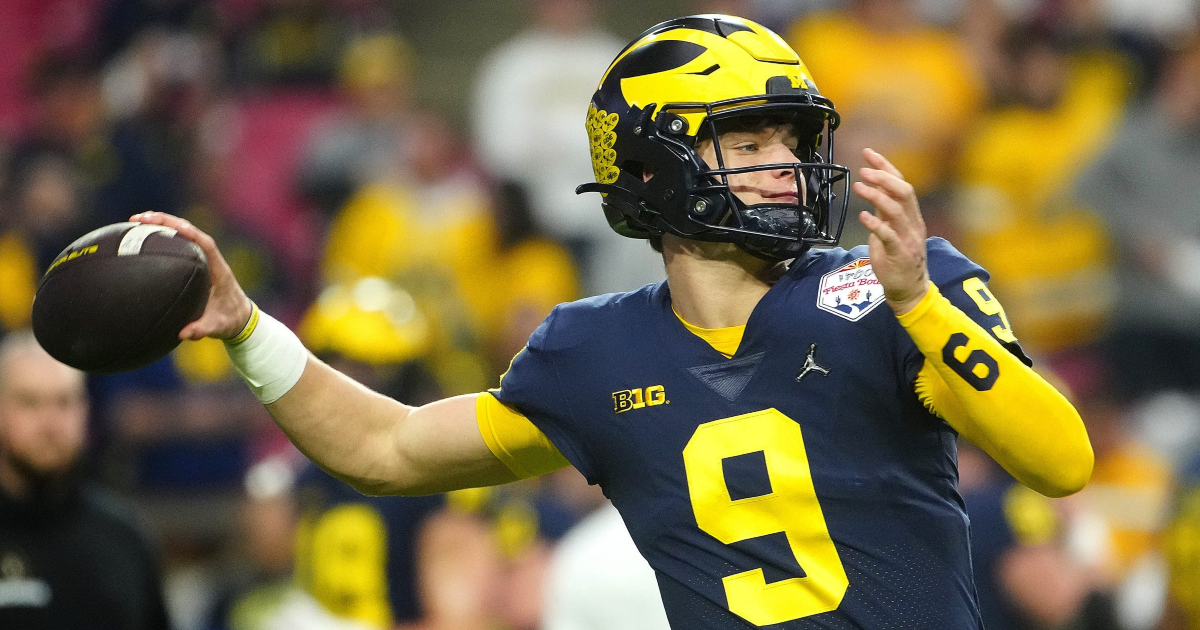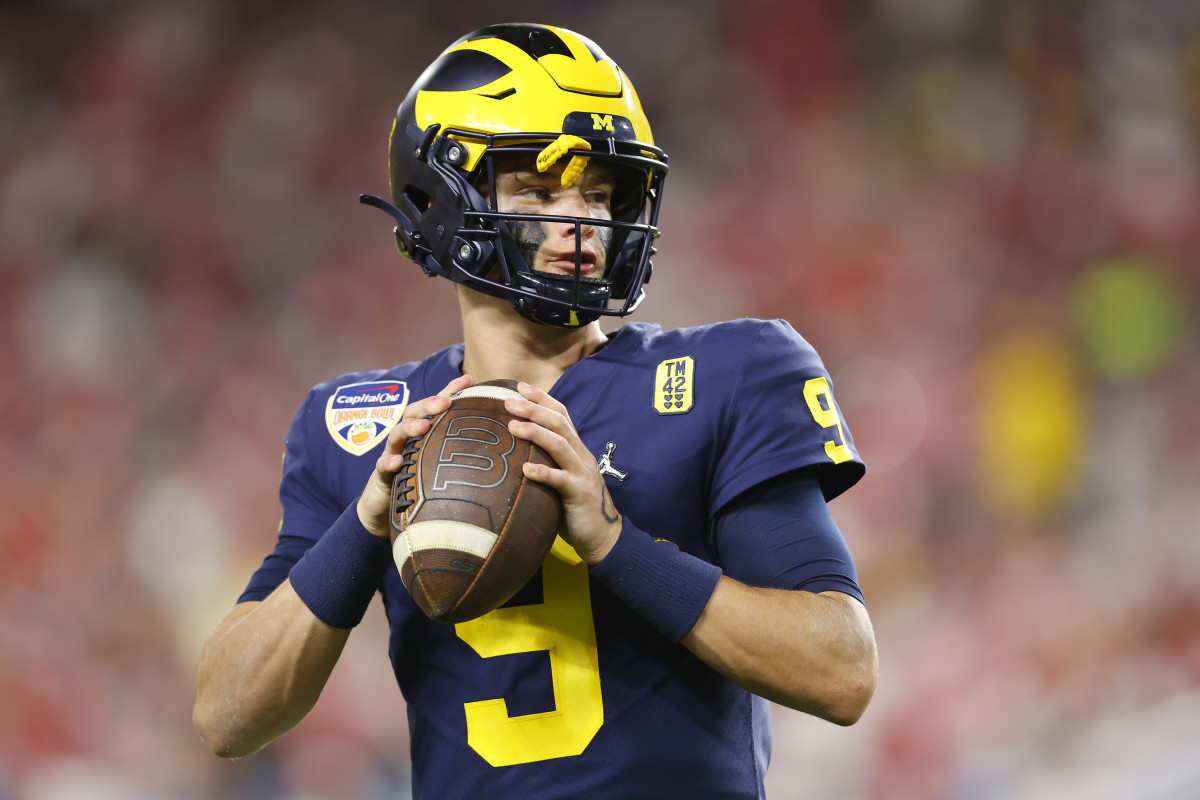JJ McCarthy’s Knee Injury

The news of JJ McCarthy’s knee injury sent shockwaves through the Michigan Wolverines fanbase. The severity of the injury and its potential impact on the team’s season are major concerns.
The Severity of McCarthy’s Knee Injury
The extent of McCarthy’s knee injury is still being evaluated by medical professionals. Initial reports suggest it could be a significant injury, potentially requiring surgery and a lengthy recovery period. While the exact nature of the injury remains unclear, the possibility of a season-ending injury looms large.
The Impact of McCarthy’s Absence on the Michigan Offense
McCarthy’s absence would be a major blow to the Michigan offense. As the team’s starting quarterback, he has been a crucial part of their success this season. His ability to make plays both in the pocket and on the run has been a key factor in Michigan’s offensive efficiency.
Comparing McCarthy’s Injury to Similar Injuries
Injuries to the knee are common in football, particularly at the quarterback position. Similar injuries sustained by other college quarterbacks have often resulted in lengthy absences, ranging from several weeks to the entire season. The recovery timeline for such injuries depends on the severity of the injury and the individual’s response to treatment.
Michigan’s Quarterback Depth Chart
In the event of McCarthy’s extended absence, Michigan will have to rely on their depth at quarterback. The Wolverines have a capable backup in Cade McNamara, who started for the team last season. McNamara has proven to be a reliable quarterback, and his experience will be valuable if called upon.
The Impact of McCarthy’s Injury on Michigan’s Season Outlook
The impact of McCarthy’s injury on Michigan’s season outlook will depend on the severity of the injury and the team’s ability to adapt. The Wolverines have a challenging schedule ahead, and the absence of their starting quarterback could significantly impact their chances of competing for a Big Ten title and a national championship.
The Injury’s Effect on McCarthy’s Future

A knee injury, especially for a quarterback, can have a significant impact on a player’s career trajectory. While the severity of McCarthy’s injury is still being evaluated, it’s crucial to understand the potential long-term implications and the road to recovery.
Rehabilitation and Potential Risks
The rehabilitation process for a knee injury can be lengthy and challenging. The specific duration and intensity of the rehabilitation program will depend on the nature and severity of the injury.
The rehabilitation process typically involves several phases, starting with immobilization and rest to allow the injured tissues to heal. This is followed by gradual strengthening and range-of-motion exercises, and eventually, a return to functional activities like running and throwing.
However, there are potential risks associated with knee injuries, particularly for athletes. These risks include:
- Re-injury: The risk of re-injury is always present, especially if the athlete returns to activity too soon or without proper rehabilitation.
- Arthritis: Repeated knee injuries can increase the risk of developing arthritis later in life.
- Limited Mobility: The injury may lead to long-term limitations in mobility and range of motion, affecting the athlete’s performance.
Impact on Draft Stock
If McCarthy chooses to enter the NFL draft after this season, his knee injury could significantly impact his draft stock. NFL teams are wary of investing high draft picks in players with significant injury concerns, especially at a crucial position like quarterback.
The severity of the injury and the expected recovery timeline will play a significant role in how NFL teams assess McCarthy’s potential. A long recovery period or concerns about future health could lead to a drop in his draft stock, potentially causing him to fall to later rounds or even go undrafted.
Comparison to Similar Injuries
Several notable quarterbacks in the NFL have sustained significant knee injuries during their careers, including:
- Tom Brady: Brady suffered a torn ACL in his left knee in 2008. He missed the entire season but returned to his dominant form, winning three more Super Bowls after the injury.
- Patrick Mahomes: Mahomes sustained a dislocated kneecap in 2019. He missed two games but returned to lead the Chiefs to a Super Bowl victory.
- Drew Brees: Brees suffered a torn labrum in his throwing shoulder in 2005. He missed the entire season but returned to become one of the most successful quarterbacks in NFL history.
These examples illustrate that quarterbacks can recover from significant knee injuries and return to a high level of play. However, the recovery process can be challenging, and the long-term impact of the injury can vary.
Return to Previous Performance Level
McCarthy’s ability to return to his previous level of performance after recovering from the injury will depend on several factors, including:
- The severity of the injury: More severe injuries typically require longer rehabilitation and may result in more significant long-term effects.
- The quality of rehabilitation: A comprehensive and individualized rehabilitation program is crucial for optimal recovery.
- McCarthy’s determination and commitment: His dedication to the rehabilitation process and his mental fortitude will play a significant role in his ability to return to the field.
While it’s impossible to predict with certainty whether McCarthy will fully recover from his knee injury, his commitment to rehabilitation and the support of his medical team will be essential in his journey back to the field.
The Role of Injury Prevention in College Football: Jj Mccarthy Knee Injury

Knee injuries are a significant concern in college football, impacting players’ careers and the overall success of teams. Understanding the factors that contribute to these injuries and implementing effective prevention strategies is crucial to ensure the safety and well-being of athletes.
Prevalence and Contributing Factors
Knee injuries are among the most common injuries in college football, accounting for a substantial portion of all reported injuries. The prevalence of these injuries is influenced by a complex interplay of factors, including the inherent physical demands of the sport, the intensity of training, and the use of protective equipment.
- High-impact collisions: The nature of football, with its frequent collisions and tackles, puts significant stress on players’ knees, increasing the risk of ligament tears, meniscus injuries, and other knee problems.
- Repetitive stress: The repetitive movements and forceful actions involved in football, such as running, jumping, and pivoting, can lead to overuse injuries and gradual deterioration of knee structures.
- Inadequate conditioning: Insufficient strength, flexibility, and proprioception (body awareness) can increase the risk of knee injuries by making players more susceptible to sudden movements and unexpected impacts.
- Biomechanical factors: Individual variations in anatomy, biomechanics, and muscle imbalances can influence the risk of knee injuries. For example, players with certain leg alignment issues or weak quadriceps muscles may be more prone to knee problems.
Effectiveness of Current Injury Prevention Strategies
College football programs have implemented various strategies to prevent knee injuries, including training techniques, equipment advancements, and strength and conditioning programs. The effectiveness of these strategies varies, and ongoing research is essential to optimize their impact.
Strength and Conditioning Programs
Strength and conditioning programs play a critical role in reducing the risk of knee injuries by enhancing muscle strength, flexibility, and proprioception. These programs focus on strengthening the muscles surrounding the knee joint, improving core stability, and developing proper biomechanics.
- Strengthening exercises: Focusing on exercises that target the quadriceps, hamstrings, and calf muscles helps to improve the stability and support of the knee joint.
- Flexibility exercises: Stretching and range-of-motion exercises help to improve the flexibility of muscles and tendons around the knee, reducing the risk of strain and injury.
- Proprioceptive training: Exercises that enhance balance, coordination, and body awareness help players better control their movements and react to unexpected situations, minimizing the risk of knee injuries.
Playing Surface and Weather Conditions, Jj mccarthy knee injury
The playing surface and weather conditions can significantly influence the incidence of knee injuries in college football. Artificial turf surfaces have been associated with an increased risk of knee injuries compared to natural grass, while wet or slippery surfaces can increase the risk of falls and collisions.
- Artificial turf: The harder and more unforgiving nature of artificial turf can increase the impact forces on players’ knees, potentially leading to a higher risk of injuries.
- Wet or slippery surfaces: Wet or slippery surfaces can make it difficult for players to maintain their footing, increasing the risk of falls and collisions, which can lead to knee injuries.
Recommendations for Improvement
To further enhance injury prevention protocols and training methods in college football, the following recommendations are crucial:
- Tailored training programs: Implementing individualized training programs that address specific biomechanical needs and risk factors for each player can help minimize their risk of knee injuries.
- Focus on functional strength and conditioning: Emphasizing exercises that mimic the demands of football, such as plyometrics and agility drills, can improve muscle strength and coordination, reducing the risk of injuries.
- Proper equipment use: Ensuring that players wear properly fitted and maintained equipment, including knee braces and pads, can help protect their knees from impact forces and reduce the risk of injuries.
- Improved playing surface conditions: Investing in well-maintained and appropriate playing surfaces, including natural grass fields and artificial turf with improved shock absorption, can minimize the risk of knee injuries.
- Enhanced education and awareness: Providing players and coaches with comprehensive education on knee injury prevention, including proper warm-up techniques, stretching routines, and biomechanical principles, can help promote safe and effective training and game-day practices.
Jj mccarthy knee injury – The news of JJ McCarthy’s knee injury sent shockwaves through the Vikings locker room. A crucial piece of the offensive puzzle, his absence throws a wrench into their game plan. The Vikings will need to rely on the depth of their roster, which is detailed in the vikings depth chart.
With the pressure mounting, it’s a test of resilience for the Vikings, and their ability to overcome this setback will be a testament to their strength and character.
The whispers of a knee injury have sent chills down the spines of JJ McCarthy’s fans. Could this be a torn meniscus , a cruel twist of fate that could sideline the young quarterback for weeks, even months?
The fate of the season hangs in the balance, as the whispers grow louder and the fear intensifies.
